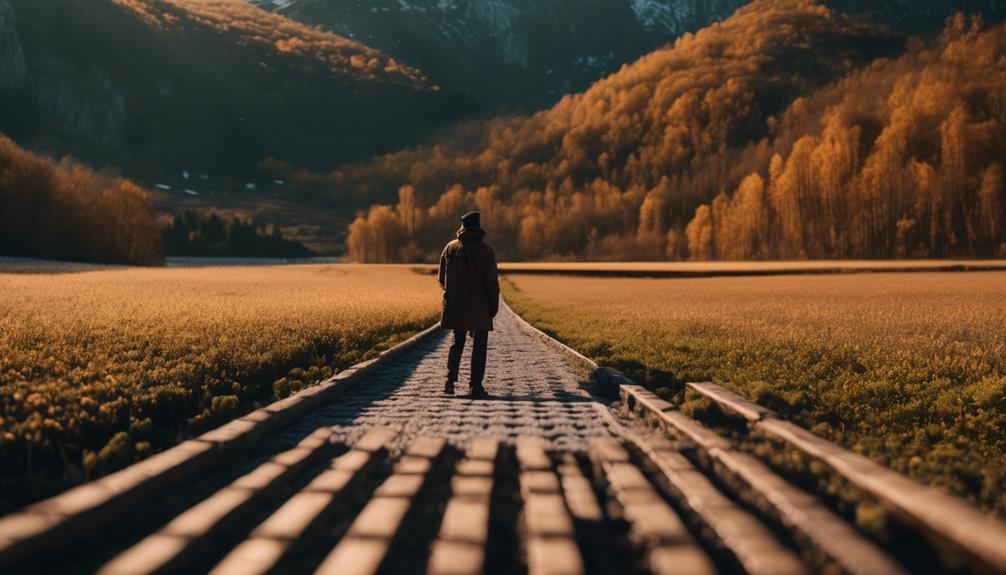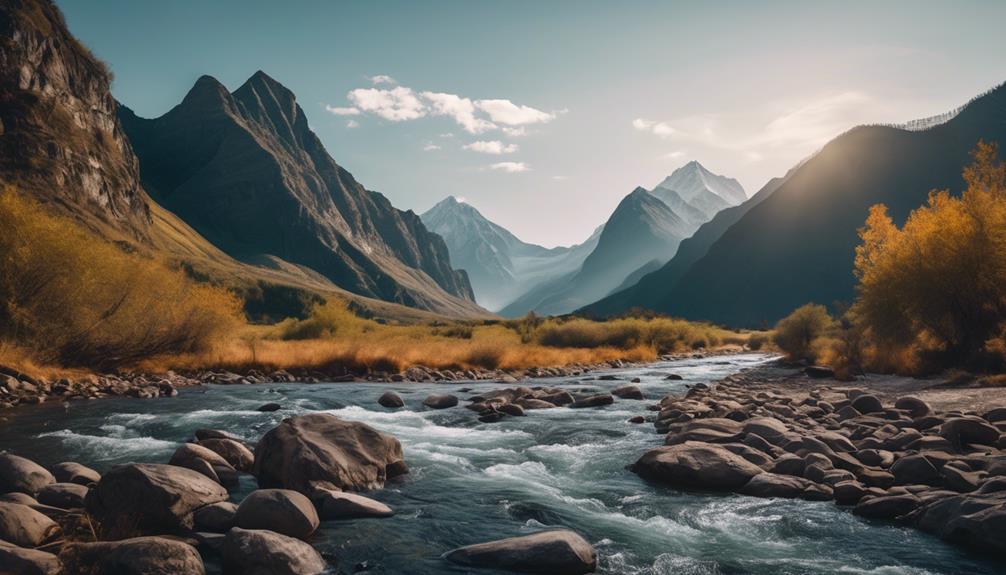Please note this post may contain affiliate links picked by me (Jay) that I have deemed may be of interest or relevant to you the reader of this.
These links do not affect the cost of the thing if you decide to purchase but i may get a little money if you choose to purchase.
For more information on my affiliate link policy click here.
As I was scrolling through my camera roll, I couldn't help but notice that my photos were lacking that 'wow' factor. They were decent, but they didn't quite capture the essence and beauty of the moments I had experienced.
That's when I stumbled upon the rule of thirds, a simple yet powerful technique that has the potential to transform any ordinary photo into a work of art. Intrigued?
Well, let me tell you, these 7 steps to improve your photos with the rule of thirds will not only change the way you approach photography, but also elevate your skills to a whole new level.
So, grab your camera and get ready to unleash the hidden potential in your photographs.
Key Takeaways
- The Rule of Thirds grid divides the frame into nine equal parts, allowing for creative exploration and breaking away from centered compositions.
- Placing subjects along the gridlines or at the points of intersection creates a visually appealing composition with balance and harmony.
- Placing points of interest off-center adds depth, visual intrigue, and can accentuate leading lines.
- The Rule of Thirds is a versatile tool that can be applied to different photography scenarios, enhancing the overall composition and visual impact of the photographs.
Understanding the Rule of Thirds
To truly capture the essence of a captivating photograph, one must first understand the fundamental principle known as the Rule of Thirds. This composition technique for better photography involves dividing the image into a 3×3 grid, with two horizontal lines and two vertical lines intersecting at four points. By placing the main subjects or points of interest along these lines or at the points of intersection, you can create a more visually appealing and balanced composition.
The Rule of Thirds isn't about rigidly following the grid, but rather using it as a guide to enhance your creativity. It allows you to break away from the traditional centered compositions and explore new perspectives. For instance, you can experiment with placing the subject off to one side, creating a sense of movement or leading the viewer's eye towards a particular area of the photograph.
Another creative way to apply the Rule of Thirds is by using it to emphasize the foreground or background. By placing the main subject on one of the intersecting points while leaving more negative space on either side, you can draw attention to the subject and create a sense of depth. This technique adds interest and dimensionality to your photos.
Furthermore, the Rule of Thirds can also be used to balance out the composition when photographing landscapes or architecture. Placing the horizon along one of the horizontal lines instead of in the center can create a more harmonious image. Additionally, aligning vertical elements such as buildings or trees along the grid lines adds structure and balance to the photograph.
Applying the Rule of Thirds Grid
As I explore the practical application of the Rule of Thirds grid, I am eager to discover how this composition technique can enhance the visual impact of my photographs. The Rule of Thirds grid is a powerful tool that helps achieve visual balance and enhance the overall composition of an image. By dividing the frame into nine equal parts with two horizontal and two vertical lines, it creates four intersecting points that serve as natural focal points for the viewer's eye.
Incorporating the Rule of Thirds grid into my photography allows me to enhance the composition by placing key elements along the gridlines or at the intersection points. This technique brings a sense of balance and harmony to the image, making it more visually appealing and engaging. By placing the subject slightly off-center, I can create a more dynamic and interesting composition, capturing the viewer's attention and guiding their gaze through the image.
To better understand the impact of the Rule of Thirds grid on composition, let's take a look at a table that illustrates its application in different scenarios:
| Scenario | Composition without Rule of Thirds | Composition with Rule of Thirds |
|---|---|---|
| Landscape photography |  |  |
| Portrait photography |  |  |
| Still life photography |  |  |
As we can see, by applying the Rule of Thirds grid, the compositions become more balanced, visually pleasing, and impactful. This technique allows for greater creativity and innovation in photography, enabling photographers to create visually stunning images that captivate and evoke emotion in the audience. So, the next time I capture a photograph, I will be sure to apply the Rule of Thirds grid to enhance its composition and achieve visual balance.
Placing Points of Interest Off-Center
Placing points of interest off-center adds depth and visual intrigue to photographs. It allows for creative composition and enhances the art of visual storytelling. By intentionally positioning the subject away from the center, you can create a more dynamic and engaging image.
Here are four reasons why placing points of interest off-center is crucial for captivating photographs:
- Balance and Harmony: Placing the subject off-center creates a sense of balance and harmony within the frame. It keeps the viewer's eye moving and prevents the image from feeling static or uninteresting. This technique adds a touch of visual tension, making the photo more captivating.
- Leading Lines and Perspective: Off-center subjects can be used to accentuate leading lines and draw the viewer's attention to different parts of the image. By placing the subject along diagonal lines or at the intersection of the rule of thirds grid, you can create a sense of depth and guide the viewer's gaze through the photo.
- Negative Space: Placing the subject off-center allows for the inclusion of negative space, which can enhance the impact of the main subject. Negative space provides breathing room and helps to emphasize the subject's importance or highlight its surroundings.
- Unconventional Composition: Placing points of interest off-center encourages experimentation and breaks away from the conventional composition. It challenges the viewer's expectations and adds an element of surprise and creativity to the photograph.
Incorporating the rule of thirds and placing points of interest off-center can greatly improve the visual impact of your photographs. It allows for more dynamic and engaging compositions, enabling you to create compelling visual stories that captivate your audience.
Balancing Elements With Rule of Thirds
When applying the rule of thirds, achieving balance between elements in a photograph becomes effortless. The rule of thirds not only helps in placing points of interest off-center but also plays a crucial role in achieving symmetry and creating visual tension within the frame.
Symmetry is a powerful compositional tool that can create a sense of harmony and balance in a photograph. However, achieving perfect symmetry can sometimes result in a static and uninteresting image. By applying the rule of thirds, we can introduce a slight imbalance that adds visual interest and dynamism to the composition. Placing the main subject slightly off-center, aligned with one of the imaginary gridlines, allows for a more visually engaging image. This subtle deviation from perfect symmetry creates a sense of tension and movement, capturing the viewer's attention and drawing them deeper into the frame.
Creating visual tension is another way the rule of thirds can enhance the balance of elements in a photograph. By deliberately placing subjects or objects along the intersecting points of the gridlines, we can create a visual tension between the different elements in the frame. This tension adds depth and intrigue to the composition, making it more visually appealing and captivating.
The rule of thirds is a versatile tool that not only helps in placing points of interest off-center but also plays a crucial role in achieving balance, symmetry, and creating visual tension in your photographs. By incorporating this rule into your composition, you can elevate your images to new heights, capturing the attention of your viewers and leaving a lasting impression.
Using Leading Lines With Rule of Thirds
Achieving balance and adding visual interest to a photograph isn't limited to just elements and symmetry; incorporating the rule of thirds also allows for the use of leading lines to create a dynamic composition. By utilizing leading lines, photographers can enhance the overall composition of their images and guide the viewer's eye towards the main subject.
Here are four ways to effectively use leading lines with the rule of thirds:
- Horizontal Leading Lines: Horizontal lines, such as a shoreline or a road, can be placed along the lower third of the frame to create a sense of depth and draw the viewer's attention towards the subject. This technique is particularly useful when capturing landscapes or architectural shots.
- Vertical Leading Lines: Vertical lines, like tall buildings or trees, can be positioned along the left or right third of the frame to add interest and balance. These lines not only create a sense of height but also guide the viewer's gaze towards the subject, especially when shooting portraits or street photography.
- Diagonal Leading Lines: Diagonal lines add a dynamic element to the composition and create a sense of movement. By placing these lines along the intersecting points of the rule of thirds grid, you can draw the viewer's eye towards the subject while adding visual interest and energy to the photo.
- Curved Leading Lines: Curved lines, such as winding roads or flowing rivers, can be used to lead the viewer's eye through the image. By positioning these lines along the rule of thirds grid, you can create a more balanced and visually appealing composition.
Exploring Depth and Perspective
Exploring depth and perspective in photography allows for captivating and immersive images that transport the viewer into the scene. By using foreground elements and playing with angles, photographers can create stunning visuals that captivate the audience and provide a unique perspective.
Using foreground elements is an effective way to add depth to your photos. By placing objects closer to the camera, you can create a sense of scale and dimension in your image. For example, if you're photographing a landscape, you can use a tree or a rock in the foreground to create a sense of depth and draw the viewer's eye into the scene. This technique adds a layer of interest and complexity to your photos, making them more visually appealing.
Another way to explore depth and perspective is by playing with angles. By changing your camera position and shooting from different angles, you can create a sense of depth and dimension in your photos. For example, shooting from a low angle can make objects appear larger and more dominant, while shooting from a high angle can make them appear smaller and less significant. Experimenting with different angles allows you to tell a story and evoke different emotions in your audience.
Experimenting With Rule of Thirds in Post-Processing
To take your photos to the next level, consider experimenting with the powerful technique of the Rule of Thirds during the post-processing stage. This technique can enhance composition and help you achieve a dynamic and balanced visual impact in your photographs.
Here are four ways you can experiment with the Rule of Thirds in post-processing:
- Cropping: One of the easiest ways to apply the Rule of Thirds is by cropping your image. Look for elements in the photo that align with the gridlines or intersections, and adjust the crop accordingly. This can help create a more visually pleasing composition.
- Adjusting the Horizon: If you have a landscape photo, pay attention to the horizon line. Instead of placing it dead center, try placing it along one of the horizontal gridlines. This can add more interest and depth to your image.
- Placing Key Elements: When editing your photo, consider the placement of key elements such as the main subject. By positioning them along the gridlines or intersections, you can create a stronger focal point and draw the viewer's attention.
- Balancing the Frame: The Rule of Thirds can also help you achieve balance within the frame. Look for ways to distribute visual weight evenly by placing elements along the gridlines. This can create a more harmonious and visually pleasing composition.
Frequently Asked Questions
Can the Rule of Thirds Be Applied to Any Type of Photography?
Yes, the rule of thirds can be applied to any type of photography. By dividing the frame into nine equal parts, it allows for more dynamic compositions.
Whether you're shooting landscapes, portraits, or still life, this technique can add balance, interest, and visual impact to your photos.
However, it's important to note that there are alternative composition techniques and different photography genres that may require a different approach.
Experimenting with these techniques can lead to innovative and captivating images.
How Can the Rule of Thirds Enhance the Composition of a Photograph?
The rule of thirds has a significant impact on the composition of a photograph. By dividing the frame into nine equal parts, it allows for more dynamic and visually appealing compositions.
In landscape photography, it helps to create a sense of balance and depth, while also highlighting key elements.
When it comes to portrait composition, the rule of thirds can bring attention to the subject's eyes or other important features, resulting in a more captivating image.
Are There Any Exceptions or Situations Where the Rule of Thirds May Not Be the Best Composition Technique to Use?
When is it appropriate to break the rule of thirds in photography?
Well, there are definitely situations where other composition techniques can be more effective. Exploring alternative methods allows for innovation and creativity in your photos.
Sometimes, breaking the rule of thirds can create a more dynamic and visually interesting image. It all depends on the subject, the story you want to tell, and the emotions you want to convey.
Don't be afraid to experiment and think outside the box!
Can I Use the Rule of Thirds With Different Aspect Ratios, Such as Square or Panoramic Formats?
Sure, you can definitely use the rule of thirds with different aspect ratios, such as square or panoramic formats.
While the rule of thirds is a popular composition technique, it's not the only one out there. Sometimes, alternative composition techniques can be used to create unique and innovative photographs.
Are There Any Specific Camera Settings or Techniques That Can Help Me Effectively Use the Rule of Thirds in My Photographs?
To effectively use the rule of thirds in your photographs, it's important to consider camera settings and composition techniques. Experiment with different aperture settings to control depth of field and focus on your subject. Adjusting the ISO can help you achieve the desired level of brightness or graininess.
Don't forget to use the gridlines on your camera's display to align your subject along the intersecting points of the rule of thirds. These techniques will enhance the overall composition and make your photos more visually appealing.
Conclusion
In conclusion, mastering the rule of thirds is like unlocking a secret doorway to captivating photographs. By strategically placing points of interest off-center and using leading lines, you can create a visual journey that draws viewers in.
Balancing elements and exploring depth and perspective adds depth and dimension to your images, making them come alive. So, don't be afraid to experiment with the rule of thirds in your post-processing. It's the key to transforming ordinary snapshots into extraordinary works of art.


